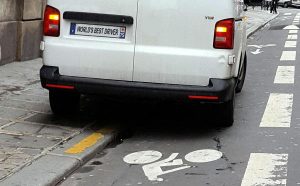
Gerald Vinestock’s experience driving in France has taught him much about the dos and don’ts and Gallicisms of the country’s byways, highways and parking lots, from Calais to the door of a small-town boulangerie. His insights will come in handy should you someday get behind the wheel in France, particularly British drivers.
By Gerald Vinestock
Everyone knows that French drivers are the best in the world. Every French driver knows that English drivers in France travel rather more slowly than French escargots.
It is the duty, therefore, of every French driver to encourage the rosbifs by tailgating any English car so that the English driver, glancing in his mirror, is able to see the Frenchman throwing both arms in the air in Gallic exasperation. Eventual overtaking can be accompanied by suitable digital indication of friendliness.
The English driver can sympathize to some extent with his French counterpart, for there are clearly two major defects in French cars—both likely to detract from the desire to establish the driver’s role as the best in the world. The first of these is that it appears the roofs of many French cars are likely to blow off at speed. For this reason drivers have to open the car window and hold the roof in place. They let go only to point out interesting landmarks—or, of course incompetent English drivers—to their passengers. These gestures should not be confused with old-fashioned hand signals, indicating a desire to turn left, for instance.

Such gestures would be useful, for the second defect is that clearly the indicators on French cars stop working as the car leaves the showroom, so that cars swoop left or right apparently at will, leaving bewildered English drivers in their wake. And that’s to say nothing about priorité à droite that curious French system which allows vehicles to leave tiny lanes and driveways by hurtling onto major roads without warning, just so long as they are coming from the right. It may be French drivers’ confusion about this business of who has priority that enables them to drive with such confidence on twisting roads and hairpin curves.
The English driver usually arrives in France at Calais where he is greeted by a huge sign: Tenez la Droite, that is, Drive on the Right. Of course, the English driver knows that all properly organized nations drive on the left, but he concentrates and keeps repeating to himself, ‘Keep right!’ and after a couple of hours on the French freeway he is feeling quite confident about this strange habit. Then he arrives on minor roads in the mountains and finds that he must have misunderstood the instruction, for now French drivers drive round bends on the left. And the bigger the car the further to the left it goes. The English driver faced with imminent collision keeps further right, eyes closed, and tries not to think about the precipitous drop only inches away.
Not only are the French the best drivers, they are the best parkers. They are helped in this by use of the sidewalk. English people know that a sidewalk—though they prefer to call it a pavement—is for the use of pedestrians. French people assume that the sidewalk is separated from the road in order to provide parking places for cars. Pedestrians, mothers with strollers, children, the elderly are expected to struggle past in the road.
 The best parkers can place their cars so close to the boulangerie door that French customers wanting to buy bread know the only way into the shop is through the back of the car. English people form a polite queue until the man emerges unapologetically and drives off.
The best parkers can place their cars so close to the boulangerie door that French customers wanting to buy bread know the only way into the shop is through the back of the car. English people form a polite queue until the man emerges unapologetically and drives off.
Since French drivers are the best in the world, the failure to spot my car in the supermarket car park was obviously just a temporary blip. The subsequent collision was at such speed that the door could not be opened and had to be replaced. The French driver knew there was no point in discussing the matter, since the English don’t speak French and would not understand. So he drove off speedily, without signaling, round a bend on the wrong side of a road, clinging to his roof with one hand and pointing out the damage to my car with the other.
© 2018, Gerald Vinestock
Gerald Vinestock recently published a children’s novel, Crib and the Labours of Hercules.

